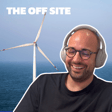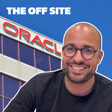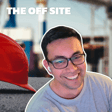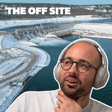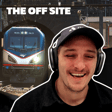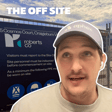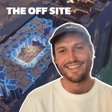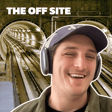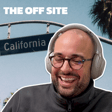Become a Creator today!Start creating today - Share your story with the world!
Start for free
00:00:00
00:00:01

The Intuitive Nature of Mapping with the CEO of Propeller
This week, Jason and guest host Mike are joined by Rory San Miguel, founder and CEO of Propeller, a cloud-based mapping and survey company based in Australia.
The trio chat about the benefits of visual information for construction, the importance of staying within the lines of what your product does as well as advice for those looking to building tech products for construction.
Follow Carlos on Linkedin | Follow Jason on Linkedin | Check out Aphex
Transcript
Introduction and Podcast Overview
00:00:00
Speaker
And it's like, and you know what? Every software team will tell you, no, no, no, no, don't worry about printing it. Just use the link. Just open the link. Yeah. Oh, it's like, just share links. And you got the office bond. Yeah. You must've, you must've heard us.
00:00:19
Speaker
You're listening to the Offsite Podcast with Jason and Carlos, where we talk all things construction and technology. Join us for discussions with industry leaders and insights into latest trends in construction.
00:00:32
Speaker
Welcome back to the pod. So again, uh, another episode I joined by Mike, uh, as a guest host Mike, how are you doing? Very well. Thank you, Matt. Pleasure to come back again. Filling in. Got the call up again to fill in for Carlos is on week four now of new dad Judy. The bench is so skinny for their podcast co-host role, Matt. So I'm back.
00:00:58
Speaker
Are you, are you hoping he extends the lead to the fifth week or, um, no, I reckon he could come back.
Bridging Project Delivery and Technology
00:01:04
Speaker
I've kept like the seeds and he's, he's ready to go when he's back.
00:01:10
Speaker
Cool, awesome. I'm pretty pumped to talk to our guests today. So I guess for setting the scene, the goal of why we started this podcast was to bring together ideas from the folks who try to deliver projects and the technology providers that were delivering the most value. And a lot of those conversations we're having on a daily basis. And I am this, I'm a big believer in the idea that
00:01:38
Speaker
the thing and the tool and the software that delivers the most I use, the one that gets used. So I have internally this like test that I use, which is what software do I see on people's like bookmark bar on their browser, whenever we're talking to customers or watching recordings of setups or demos.
00:01:57
Speaker
And it's hard for me to find a more commonly used platform than, uh, than Propeller. So I'm super pumped to be joined by Rory, Sam Miguel. Rory is the founder and CEO of Propeller. Mate, thank you very much for taking the time.
00:02:13
Speaker
Yeah, it's a pleasure. Very excited to be here. And I couldn't agree more with your intro there that the bookmarks bar is a really telling piece. We see, I mean, I'm most proud when it's email, calendar, propeller, and then whatever else is going on. So yeah, I do take note of that too. If you're ahead of the bomb, the Bureau of Meteorology, you know, you're doing well, that's like, that's the bar to get ahead of.
Propeller's Role in Construction Mapping
00:02:38
Speaker
Although I did see a guy's bookmark on a recording the other day, where in this little menu, he had like several bookmark folders. And in each folder, he had probably like 50 to 100 bookmarks. So I don't know. That's definitely not me. I'm not that guy. That being said, I think the bookmark we come up against the most is probably the fantasy football tab or bookmark that exists at a lot of our customer sites. So yeah, if we're ahead or behind fantasy football, that's the question.
00:03:07
Speaker
Okay. Right. Oh, yeah. At the risk mate, I've, uh, I've been super impressed at understanding like some of, and I won't claim to understand the full extent of some of technically what your hardware software, et cetera, does. And I know lots of, uh, lots of people listening in Australia will know exactly what propeller does, but at the risk of asking you to repeat a spiel that you've probably repeated.
00:03:33
Speaker
6,500 times for some of the audience that will be based in the UK or other places. It would be awesome to understand what your product does. I could try and explain it, but once I hit the word photogrammetry, I'm like, everyone will know I'm well beyond my skis.
00:03:50
Speaker
to ask you to explain what Propeller does. Fantastic. So we make some hardware and we make some software. The hardware we make GPS based products. We focus on high accuracy GPS or RTK or PPK for anyone that's in the world of survey. So we build, for example, our most popular product, our most popular hardware product is the arrow points. The arrow points are these visible targets, checkerboard style targets.
00:04:16
Speaker
50 centimetres by 50 centimetres and they are used to reference drone data to make that drone data really accurate and then our software works really closely with that of course and what we do really as a business is we're a cloud drone data processing and analytics solution. We sell you the software and the hardware that you need to go out and do your own drone surveys
00:04:38
Speaker
Our hardware makes that really accurate and easy to do. Our software does the processing of that data, so we're essentially stitching lots of individual photos, thousands of photos together into one big, seamless 3D map. Again, because of that hardware, our 3D maps
00:04:53
Speaker
generally three centimeters accurate vertically so right down there with sort of GPS grade accuracy that you get from a rover and then we have a web platform think of it as Google Maps on steroids for your construction site you can fly as often as you want you those maps get updated you can kind of scrub back through time off the back of that elevation data we're getting one of the common use cases very common is quantifying material on a work site whether that's
00:05:20
Speaker
stockpiles that are coming in or how much material you've moved with your earthmoving fleet so that's really what our customers do is they move a lot of material they're using propeller to survey their site they're using propeller to quantify how much that site is changing over time and then more and more as we go and what we're hearing from our customers is
00:05:40
Speaker
Propeller's being used to collaborate, to discuss, to plan. You walk through a side office and you might see a few screens up and a few people crowded around. And they're just kind of using it as a way to dial in the conversation that they're having and bring context to people so that they're all talking on the map. And I think philosophically what we believe is that the map and mapping data in general is really intuitive.
00:06:06
Speaker
There's no language barrier. Uh, it works really well on mobile devices. I think Google maps has done a great job of putting maps in our pocket. Repel is the extension of that for work sites. And because of how familiar we all are with maps and spatial things in general, I mean, we exist spatially, right? Everything we look around, it's how far away is that thing? And that we have this innate spatial understanding. And I think this propellers that the digital version of that.
00:06:32
Speaker
where we see it going is that this drone map happens to be a really convenient, accurate, high-quality wave surveying site, but it also becomes an interesting place to centralize a lot of your data and your workflows, where instead of being organized in folders,
00:06:51
Speaker
or on desktops or with times, like you're actually just pinning things directly to the map where they exist. Because again, in construction, everything has a time, everything has a place. And I think, yeah, our data is essentially capturing the site in that same paradigm. And that's what has become so good about, I think, the product and driven a lot of the uptake and a lot of that tab action that you see. Yeah. One of the things that we do on almost every demo or setup
00:07:21
Speaker
for a customer from the HPX site is asking like, what are they building? Talking about the front line. And then everyone's intuitive action is get a map up in Propeller or, you know, Google maps and go, we're doing this from here to here. And then yeah,
Simplifying Field Data with Propeller
00:07:36
Speaker
100%.
00:07:37
Speaker
I was so we're moving offices at the moment. This is a side note, but we're moving offices and we're trying to sublet our current office, which I'm currently in. And someone called me earlier and say like, Hey, I saw your post and I'm curious about the office. Can you sort of explain it to me? And I was trying to explain the layout of our office using words, which
00:07:57
Speaker
is insane. And like, you know, Propeller exists in maps, we are a mapping company, we are mapping nerds, we are GPS nerds here. And I'm just going, I'd love if there was just a map, you know, why am I having this discussion? I'm saying the northeast corner and instead I can just pull up a map and see it all and talk someone through it as if we're in the space. So it is really that step shift going from
00:08:21
Speaker
PDF drawings with contour lines that are understandable if you are technically trained, but are not understandable if you're just in a field, right? And Propeller is 3D. It's actually 3D. It's not contour lines. It's actually 3D. It's in the browser. It's available on your phone. And yeah, that's exactly to your point. That's what makes it really valuable.
00:08:43
Speaker
If you could get to even describing that you're the Northeast corner, you're definitely like seven steps ahead of me. You could put me in any room and put a gun to my head and said, which way is North? And I'll be nine times out of 10 wrong. Well, I thought bad for this guy that I was talking to, because I was like, does he know which way North is? And I do, because we live in this world, right? But when I was like, God, is this a flex that I'm saying like North and South and East?
00:09:12
Speaker
Yeah. It's like when people use phonetic alphabet and stuff. Like I'm just like, okay, okay. You know where North is. I don't. Yeah. Yeah. And I didn't, you know, that's, and that's, that, that gap between GPS nerds, GIS people, survey people like us, and then people that are in the field, that gap exists in construction. And I think propeller stumbled into that honestly, but it's giving everyone that shared language and shared understanding, um, that has driven the business for sure.
00:09:39
Speaker
Yeah, so I guess you and I, when we spoke the other day, I sort of made up this invented paradigm of like, or maybe you had mentioned it or someone else, this idea of like front of house and back of house software that like for construction teams, there are certain processes like paying people, like commercial forecasting.
00:10:01
Speaker
maybe like safety documentation and reporting that give my classes back of house that support functions and other teams will you do on a, on some sort of cycle. And then that there's certain tools that front of house teams, like the actual people needing to build the thing every day, go out and make source stuff happen, solve problems, fight fires. There's certain tools that they need and use and that there's like a lot of software in that back of house space.
00:10:29
Speaker
There's like a big graveyard of stuff in the front of house place because the bar is like so much higher to be successful in that front of house software. The people are way busier, the room for error and the patience and the ability to like play around and deal with bad tools. It's wildly different. The thing that I've observed is in construction software, there is so much stuff that just isn't at the level that that front of house team needs and propeller in my
00:10:59
Speaker
view from watching teams use it as doing a tremendous job over a long period of time. So I guess the question that I'm leading to is what, what in your view does it take to make
00:11:11
Speaker
a tool that those front of house on the ground delivery team folks will spend their time in and I guess then ultimately advocate for and use. Before I answer what it takes to build that, I think I'll answer what it is first for those people that are front of house to use your language.
Aligning 3D Designs with Reality
00:11:31
Speaker
You know, the projects that we work with all have
00:11:36
Speaker
3D designs that are being built by those back-of-house teams, right? So they're taking the drawings from the client, the kind of scope, they're building out those 3D designs, those surfaces, they're sort of putting in line work to show where curbs and gutters are going to be. These are all conceptual designs.
00:11:57
Speaker
And there is a massive gulf between a conceptual design and the real world. And really, how do you close that gap? Those designs are all really created in really advanced CAD packages from a business center, Autodesk products, et cetera. But then what do you do to show someone to get their feedback?
00:12:17
Speaker
And we hear about things all the time where, for example, the designer sitting in a nice office puts the design together. And then what happens is they put it in Propeller. And in Propeller, that design is visualized in 3D. It's in the right coordinate system. It shows up exactly where it should be. There is also a drone survey there.
00:12:37
Speaker
And straight away, someone will say that there's a heritage listed tree that's right in the middle of the design. And they won't be able to see that from the office. They won't go to figure that out from the office, but someone looking out in the field that knows the practical constraints of the site can say, we can't touch that tree. Then there's a lap, right, where that feedback goes back to the designer with the screenshot, generally a report from Propeller and says, you know, make some adjustments and they'll go away and adjust and come back. And so that process needs those two parties, the office and the field to be
00:13:06
Speaker
collaborating, but then how do you move the 3D file? Like, there's no sharing, collaboration tools built onto those design platforms, right? So, propeller becomes that interface, I think, between the office and the field, then it becomes that interface between reality and the design.
00:13:23
Speaker
it's the bit in the middle, which is the messy bit, which is the hard bit, as far as we hear from customers. So that's, I think, an example where it's all well and good to have the design. It's all well and good to produce nice isometric drawings of that design to make it really intuitively understandable to someone that understands the constraints of the site, the practicalities of the build.
00:13:44
Speaker
That's one of the examples, right? Another example is formative superintendents that are reporting their quantities on a daily or weekly basis. Previously have to rely on survey teams to do that. Now the survey teams, vet propeller, is it accurate enough other quantities as I would produce? How hard is it? Is it easy to get it wrong? If we kind of pass all those hurdles from the survey team, survey team says to the formative superintendent, you can do this yourself now.
00:14:12
Speaker
And then at the end of the week or the day, they get a drone survey done. Often they're flying the drone themselves. The data comes back pretty quickly these days, within a few hours generally. They sit there and they draw the polygons, produce the cuts and the fills. And now they've become sort of self-sufficient, right? In a progress tracking capacity.
00:14:29
Speaker
And then the survey team is freed up to do more complex work. And they're not a bottleneck across half a dozen sites that are asking them, hey, where are we at on this? What's the latest elevation here? All that grade checking, all of those kind of spot checks are happening. It's a closed loop in the field. They're able to do this and solve their questions themselves. So that's really what I think, when you say,
Customer-Driven Development
00:14:54
Speaker
you know, front of house, back of house, or in the field in the office. Like for us, that's what makes Propeller an in the field tool. We have so much planned to enhance this. Like we've got a mobile app. You can see it all in 3D. You can see your designs. You've got that blue dot that runs around the map where you are. So you've got all that context, but we want to enhance the mobile app significantly, letting you do a lot of those measurement reports, et cetera.
00:15:17
Speaker
For the guys on the ground that are in that like delivery role, like tangible benefits that solve something that they used to do manually is probably part of it. And this was going to be the how. So how is, I think ultimately we've had to listen and ask our customers and listen to them really carefully and closely. What are the problems that you've got that we can help solve? Everyone says you have to do this as far as like not many companies actually seem to do it. We do it. We do it a lot here at Propeller.
00:15:46
Speaker
So we've iterated and sort of, you know, tried to seek out those problems that we can solve. And then you need, I think you need to be really skeptical of yourself when you're building these products. You need to assume you're not going to crack these people in the field. You need to go to great lengths to disprove that, that you won't be able to crack them. You really need to try and, you know, I think technology companies come in with like a slightly, like an air of arrogance.
00:16:13
Speaker
around this is we're really good at this it's fancy software like it's awesome you know we're gonna save you lots of money at the end of the day i think we need to turn that right down turn up the humility significantly these are busy people they have been building things far longer than we've been building software we can't assume there's massive games to be had it's these incremental small things real problems that you need to solve
00:16:36
Speaker
to get them to spend their precious time with your tool and ultimately needs to be valuable, be more rewarding than it is effort. And that's just taken us 10 years. So Propeller's coming up to 10 years old. It's just been a slow and incremental journey to becoming more relevant. And again, this is just the beginning for us. We think there's so much, so much more we can do for people in the field.
00:16:56
Speaker
You're right. Everyone says you got to listen to customers and users and like, uh, and I've been as guilty as, as any to like having an amount of hubris that like, okay, you know, there's a better way to do it or whatever. Within that though, I'm sure you get the classic there's like that paradigm where.
00:17:15
Speaker
The person you're really trying to help is the busy person that isn't going to spend a bunch of time writing into you with feature requests and ideas. And then there's like this kind of like less relevant persona that would be nice to help, but they're not the core person.
00:17:31
Speaker
you're trying to solve problems for, but they'll write to you with a million feature requests and suggestions and, you know, banging on chat. How do you pass, you know, what's the filter and how do you deal with, um, working out what's real and what's not real, what you should do, what you shouldn't do.
00:17:48
Speaker
For us, the dynamic is there is generally a survey manager or survey team that we work with to begin with. And we want to work really closely with them. And in fact, we're probably solving their problems more than the people that they serve. We're helping them get their data process faster, kind of freeing up time from their specific job.
00:18:11
Speaker
They are technical. They vet us. They have high standards of data accuracy and quality. And we want to be fully legit. We want to satisfy their needs entirely. And so that's kind of step one. From there, it's the hub and the spoke model is how it's referred to internally. They're the hub. And then the spokes are all these sites and teams that rely on them. And those survey managers start to
00:18:36
Speaker
start to give propeller to their teams, because it's designed for that. And they act as this really amazing ally, where we're working with those survey managers. They're sort of collecting feedback. They might be doing a bit of training on the tools, or they might be pinning our team to organize training. Now, survey people are very busy. It's not that they're not busy. It's that they have a lot to gain.
00:19:00
Speaker
by their teams adopting propeller. And not everyone believes this with, especially a few years ago, we had challenges with the survey crews who thought the propeller was competitive to their core trade. That's really subsided now, which is fantastic. And by and large, the predominant sentiment is drones don't replace surveyors whatsoever. They're a tool.
00:19:23
Speaker
uh to assist survey teams and potentially to allow some of the end users of the information to self-source right um but we have that that sort of two-party dynamic that gets around the problem that you're talking about so
00:19:40
Speaker
Now, there's a risk there in that the way that survey people will translate feedback from foreign superintendents to us is slightly incorrect, but it's better than nothing. And it's there, you know, again, this allyship between propeller and the survey crews has been really rewarding, I think.
00:19:59
Speaker
we trust them massively and they've looked after us so far. So I think that's how. And yeah, if you can find that, if you're building technology products, you can find that dynamic. I think, you know, they ultimately end up being your champions, right? You need that to kind of to help these organizations fully.
00:20:17
Speaker
Also, I've got about 700 follow-on questions, but Mike, I'll let you jump in, mate. I'll get one in before you get excited and take the second half, mate. When you were talking about that, particularly the intuitive nature of what you're doing, reflecting back to how spatial we all are, I was really interested to unpack how you balance. Obviously, we're dealing with highly complex data,
00:20:44
Speaker
very different systems and hardware. And when you think about those champion users who are sitting in the survey teams, for instance, very high bar, probably used to reading very large documents with very large onboarding or training programs. And then when you think about the practical users out in the field who are looking to extract the value quickly, how do you go with balancing that complexity and simplicity? Because a lot of tools
00:21:12
Speaker
I feel like almost like to pack in the complexity and just put that burden back onto the user to then figure out. And what I've observed from you guys is you somehow are able to balance that complexity and technical difficulty whilst making it really intuitive and accessible for users to come and get value out quickly.
00:21:33
Speaker
I think it's a really good question. I was talking to a customer a few weeks ago and they were asking us to extend our design visualization capabilities into design creation, which is where it always goes.
Balancing Simplicity with Features
00:21:48
Speaker
Now, the good thing is this customer had been a customer for a while. And I was able to say, and I reckon two sentences, hey, you can already do this in your CAD packages. Are you sure you want us to do this and potentially ruin the simplicity of repeller for all of the people that rely on it that are less technical than you?
00:22:09
Speaker
Are you sure you want us to do that? And they said, actually, no, I get it. I get where the dotted line is around propeller. And I think we need to be really clear about that. If we take a small step out of that dotted line, all of a sudden, we open the floodgates for a ton of feature development along that vector. So for us, we have no issue with CAD programs. We love CAD.
00:22:37
Speaker
People have fantastic CAD tools. What's the point of us trying to replicate it, not to mention all the challenges of doing it in a browser compared to doing it on a high performance desktop environment? So that's just one example where I think, honestly, it's taken a lot of intuition from us, a lot of listening to customers, of course. Now that we have sort of that dotted line pretty clearly carved out,
00:23:01
Speaker
we can easily explain it to customers and they come back and defend the need for simplicity too. I think that's really important. The people that previously wanted technical things realized that there's more value for them individually in keeping Propeller simple.
00:23:19
Speaker
Doesn't mean it's not hard. We are in the process of rolling something out that is actually quite complex and so much energy has gone into trying to make it simple. You know, that phrase, you know, I was going to write you a short letter, but I ran out of time. Yeah. You know, it's easier to write a long email than a short email in many situations. So I think that paradox exists with software. It often take, it's much harder to build less. Yeah.
00:23:48
Speaker
than to build more. And so it's just a constant dance. And we have a ways to go, I would say. Yeah. Now, Mank's complete sense.
00:23:56
Speaker
I'm back in memory, Mark. But that was exactly the thing that I was had in my mind with the questions I was asking as well, that like, you could give a new interface with a lot of those design packages. There is the tendency for feature requests to come that pull incremental complexity from those packages in, which is kind of what we see from like scheduling. So we see incremental requests for P6-like functionality.
00:24:21
Speaker
and you constantly have to defend and understand where the dollar line is to not magically bloat. You know, exactly as you said, once you start walking in that direction or along that vector, you don't know where you stop. Yeah, and it's hard to stop. It's hard to undo the expectations that you set, you know, with your customers. Yeah, 100%. I think the simplicity is
00:24:43
Speaker
is not to be underrated. And even our mobile app, like it's pretty basic right now, embarrassingly basic, but at least it's not complex. Yeah. And we can add functionality carefully, but we're starting off with a pretty straightforward map viewer on your phone. So yeah, that's, that's our compass on it. It's a lot easier to add features or complexity than it is to try and add in simplicity later.
00:25:07
Speaker
or take it away or chaos. Taking away things is hell. For anyone that has an software company, you might think it's easy to just build, add things and take things away. It is torture. For you, it's torture for your customers. It's one of the worst things. Roy.
00:25:22
Speaker
You're not originally from like a construction or a mining background, I don't think. And so either your product kind of found this market or this market kind of found your product to a degree. As a result of that, do you get a lot of folks from construction come ask you advice about starting companies, starting software companies, entrepreneurship in like a construction or mining space?
00:25:48
Speaker
I get my fair share of that. My approach to this has been to generally be as open and transparent as possible, which is to say, I am a robot nerd. I'm not an Earthworks nerd. And so what that means is our customers need to teach us about Earth's moving and we can help them with robots and software. I don't pretend to
00:26:13
Speaker
know everything and I think that's where part of the culture that we have internally comes from around not carrying that software company arrogance and being really humble about what we're good at and what we're not good at and knowing what our customers are good at and where they need us to help them.
00:26:29
Speaker
90% of our product development probably gets driven by actual people that I went and caught up with a few weeks ago in Tennessee in the US. So because I'm an outsider, Propeller needs customers to drive the direction of the business.
00:26:47
Speaker
I can't fall back on my experience, right? And I think that naivety keeps us fundamentally open-minded. And I think we can solve problems in a unique way because we don't have any of the legacy necessarily.
Innovative Approaches in Construction Tech
00:27:00
Speaker
And so those arrow points, for example, I mean, it's a pretty simple idea. You take a GC, a ground control point, which has been around, I don't know, since...
00:27:08
Speaker
50 years, whenever the first aerial photographs are taken, I'm sure. So you've got a ground control point, normal thing. You've got a GPS, normal thing. GPS rover. No one had really put them together until we turned up. And it's a patented product and solved more than 30,000 of them now around the world. So I think you need an outsider's approach in a way, in some cases. So someone needs to describe the problem, and then outsiders can think creatively about the solution. And that's how we work with our customers.
00:27:38
Speaker
all the time. I was going to ask you what advice you give to those folks, but I think what you've just described is probably the perfect advice because something that I probably observe a lot with founders that go from construction, and I'm constantly reevaluating myself on this paradigm as well, is like people come to it with the knowledge that they have and applying that to solving the problem as they see it.
00:28:04
Speaker
And you see a lot of software and construction where it's like how Bob does, you know, site diaries, for example. And the product is just a hundred percent what their spreadsheet was or whatever they used to do. And yeah, like I said before, I've been a victim of that hubris like many times. I think that advice of open-mindedness is probably like the top, the top of the list. Yeah. And look, sometimes, you know, we get it wrong too.
00:28:34
Speaker
I don't know if you have this, if any of our customers are listening, we've had this feature request for a few years, many years. I'm not going to own up to how many years, but just one day after founding sub holders to measurements.
00:28:49
Speaker
we've gone through the cycles of like trying to reinvent folders and I think every software company does and then you have to realize like folders are fine folders aren't the issue and like let's not spend our creative energy reinventing folders let's just give the people what they want which is folders and subfolders and don't don't get too smart about it so I think we go through these
00:29:12
Speaker
cycles. And I'm not sure, do you have any of these feature requests that you like? You've like over engineered, you've shot past and they're just like, why don't you just give me a fold? Like, what's your equivalent of this?
00:29:27
Speaker
We went through this whole journey of one of the tricky things that we struggled with at the start is what most people do when they're planning if they're using something like Microsoft Project is this interaction of building nesting through like indentation, the way you would in like Markdown. And that fundamentally falls apart in a multiplayer environment where people are looking at subsets of the data and it's all a live environment because people start indenting other people's work and putting other people's work accidentally in folders.
00:29:56
Speaker
And in order to get away from that, we were going to make more explicit folders.
00:30:04
Speaker
for some stupid reason in my own mind, we didn't want to make folders. We started with a thing that we called groups and they would only have one level of nesting, not multiple levels of nesting. And then the feature requests started coming multiple levels of nesting. And then you have another level of nesting. And then the very next feature request is can I have another level of nesting? And you know how this goes. You just have to let customers organize their data as they want to do it.
00:30:30
Speaker
We stupidly stack so much functionality on top of that one level of nesting that it made it almost impossible for us to get to the second level of nesting without breaking a lot of like, we had like, uh, if you're in this thing, it bought over signs due to certain things. So there's like conditional rules based on the nesting. And so we'd been on a long journey for many years of like winding our way back to, uh, November last year we shipped folders.
00:31:01
Speaker
Rory could save you like three years of heartache range. We're still going through this ourselves. Like that's, you know, as much as I can, I can spit out the advice pretty easily, but here we are suffering through it as well.
00:31:19
Speaker
Because some of our customers will be listening, we won't go into any more of those because there's a long list of them. On behalf of your customers, build folders.
00:31:33
Speaker
Folders are done. Folders are done. Here's top tips on like, don't reinvent the wheel. Folders, people love. PDFs, people love. And emails, people love. All three are valid, legit ways to export and use your platform. Don't try and reinvent it. Like that's just the basics.
00:31:51
Speaker
Well, yeah, well, that probably touches you. Your top two touches on the two biggest ones for us is like, whenever we ship functionality, we'll like, we spend ages, uh, refining exactly how it will work in a multiplayer, you know, mobile in web app. And then the first request when we ship it, if we haven't done it already is, can I print this?
00:32:12
Speaker
Yeah. And it's like, it's like, and you know what? Every software team will tell you. No, no, no, no, don't worry about printing it. Just use the link. Just open the link. Yeah. Oh, it's like, just share a link and you got the office bond. Yeah. You must've, you must've heard us. It's like, just the link's fine. Right. And the customer's like, listen, listen, PDF print that that's what I want.
00:32:39
Speaker
We have a little game, which happens internally. Sometimes we ship the functionality to just throw it into beta, and then we'll ship the printing and the stuff after. And we have a little game of how long it will take before the first feature request comes from, can I print this? And I think it was October last year or something, we shipped a board view of the plan. And it was about 45 seconds to a minute before the, this is great. Can I print this?
00:33:06
Speaker
Yeah, we spent like six months last year overhauling all of our printing and reporting capabilities.
The Role of Printing and Simplicity in Software
00:33:12
Speaker
So now you can put anything on the map and you can open up a large format printout and just like move the screen around and export as a PDF in a different size thing. It's the simple things, guys. And that's back to the point around how do we balance simplicity and complexity? You let people bloody print PDFs. That's how you do it.
00:33:34
Speaker
PDFs, you know, piece of paper doesn't run out of batteries. You don't have to change the brightness on the screen. You're not getting called and text messages from your family while you're, you know, like, there's lots of advantages in some situations to that analog stuff. So I think slot in, don't try and reinvent the wheel. Like be creative where you need to be creative. Don't be creative everywhere. That's a waste of energy. A hundred percent. You do sound like you've spent years as a construction superintendent.
00:34:03
Speaker
Really? I kind of, I'm like the salty old dude, you know, product team. I'm like, guys build folders, like, like, no, no, no, we've got this better idea. I'm like, you never have a better idea than folders. No, I've never had a better idea. Just build folders. Um, I'm conscious of time. So I wanted to get onto one more topic before we run
Telematics and Real-Time Terrain Modeling
00:34:24
Speaker
out. The, um, the other week there was a, uh, where they would have guessed on the podcast a couple of weeks ago that then we were talking about.
00:34:32
Speaker
Um, planned equipment. And I know there's a lot of overlap between what you do and, uh, earth moving plan equipment and this idea of mixed fleet tracking of fleets, the data from fleets, the analytics. And, uh, that then led to a, I guess a LinkedIn discussion around who is, who's gonna, how's that going to evolve? Are OEMs gonna keep upping the game of analytics and availability of data through API so that.
00:35:02
Speaker
Maybe there's a software layer that can sit on top order. The software technology companies and hardware companies need to build, I guess, hardware that attaches and whatever to the machine. I'd be interested to know if you have a take on that because you're much closer to it than I am. Yes. I'm trying to find our thing. Oh, there's one. So we do have a take on this. Let me show you what it is.
00:35:30
Speaker
at least you know it wasn't prepared earlier than if it was to go fine. All right, so we talked about what propeller does, mapping, drones, et cetera, tracking progress.
00:35:42
Speaker
Our customers have gone from flying monthly, fortnightly, weekly, twice a weekly, like in some cases every day. So the frequencies increasing gets up to a point where it stops kind of getting practical and you got to do too much work to analyze the data to get value from it incrementally. So, you know, there are like natural ceilings on how frequently you want to capture.
00:36:02
Speaker
Of course, these sites are moving. And in many cases, 24 hours a day, they've got a lot of material to move. And so we went on the journey of what kind of augments the drone? How do we solve this problem in other ways or in other contexts? Given our hardware capabilities as a team, as a company, the GPS proficiency that we have, the survey sort of DNA in the business,
00:36:26
Speaker
branched out to a degree, and we've built our own machine tracking solution. Machine tracking solutions, there's a million of them. Telematics, I'm sure many people hopefully listening have telematics to some degree on their machines already. What's different about our telematics is that when you put our device on the machine,
00:36:45
Speaker
you essentially measure up down to the ground how high is the device off the ground and then we're using RTK or very accurate GPS right as that machine's moving we're subtracting the height of the device down to the ground and then as the machine's moving across the ground we're actually picking up the elevation under that machine now if you do that across all the machines especially all the machines that are cutting
00:37:07
Speaker
or feeling like doing the material movement, you end up being able to build a live terrain model, live topography on the work site. So this product and this software suite bolts into regular propeller where you've got this big drone survey coming in every week, say. And that resets all the elevations. It's super accurate. And then you've got these guys called dirt mates that are magnetic solar powered devices.
00:37:35
Speaker
slap it on the top of the machine, it streams all of its data back to our servers. And then we stitch all of that into the drone map and make a big 3D model that's updated every 30 minutes. Now, that's what makes it different to traditional telematics, right? Because normal telematics has lower accuracy GPS. It's just a dot on the map. We're actually getting elevations. But it also does the generic telematics things. So for example, even though it's not wired into the machine,
00:38:04
Speaker
Once you put this on a machine, if you turn the machine on, we start to feel the vibration at the RPM of the engine. And so we can tell when a machine is on, off, idle, moving, working, et cetera, through vibration. We count up all of the cycles that are happening automatically. So if you've got scraping fleets running around, we calculate how many cycles those scrapers have done. Today, they're using the clickers, which is error prone.
00:38:31
Speaker
As you can imagine, people just maybe press a couple extra times. We also calculate the length of the cycles, the average speeds. There's an element of who's moving the most material, not just scrapers, of course, but any machine that's cutting or filling. We're able to derive those operational metrics around cycles, loads, dumps, counts, distances, lengths.
00:38:57
Speaker
idle, et cetera, and were able to derive the surface that's resulting off that work.
00:39:04
Speaker
And that all adds together to get you essentially a daily report at the end of the day. And we're trying to get to daily progressing productivity tracking that's fairly hands-off. You get a daily report that says, this is how much cut and this is how much fill. These are all the cycles. This is the idle time, aggregated idle time, 15 hours of total idle. There are all sorts of things that come on this report.
00:39:28
Speaker
And it's giving our customers that real-time sense. So for us, the reason we've gone with a hardware to answer your question initially, a hardware and software solution here rather than just software, is because none of the existing telematics solutions do survey data. You can get survey data off the machine control solutions, but you're in for 50 grand each per machine to get machine control. So there's going to be many machines where it doesn't make sense to put machine control on. You're never going to get that data from them.
Challenges and Appreciation in Construction Tech
00:39:53
Speaker
And the software backbone of all the machine control systems is not where you'd need it to be in 2024. It's kind of, they're not cloud, they're not streaming. It's like, it's a different architecture from a sort of 10 or 15 years ago, really.
00:40:08
Speaker
Now, our customers are all mixed-flate. Everyone is mixed-flate. I don't know anyone that's not mixed-flate. No one's so, yeah. It's a myth, right? Now, what I find weird is that companies spin up, have bespoke solutions like these, then they get bought by one of the big OEMs, Kat Komatsu, that then becomes proprietary, walled garden, to try and add competitive advantage or defensibility differentiation on the machines themselves. And we can't
00:40:36
Speaker
we don't think this is a viable approach. We think there needs to be that common layer. And it needs to be hot-swappable, easy to move and change, because the fleets are always changing their composition. And importantly, it needs to be low cost. So our stuff, like $1 or $2,000. The answer to my question, for sure, then, is 100%. Yeah, OK, software, hardware on the machines, not the OEM. So that's you and Tommy. I think the OEMs must be.
00:41:06
Speaker
The OEMs simply aren't incentivized to share their data.
00:41:11
Speaker
Yeah, but wouldn't they be incentivized to sell like the kind of like Tesla FSD, aren't they incentivized to sell a reasonable upgrade package of it and bundling with that proper streaming of event data? Yeah, but they can do that, but it streams into like cattelematics.com. It doesn't stream to a generic general, like it, so they, they do that. They upsell telematics, but it, but then you have a portal for the cat stuff, a portal for the kamatsu stuff, portal for jumps, et cetera.
00:41:39
Speaker
but like where's the incentive to close that OEM brand gap? Now I should say there are ISO standards coming down the pipe for some of this machine data so it's going to get more open. Even then it's not survey data so for us we think and then survey data is its own beast. Machine manufacturers and not survey people
00:41:59
Speaker
Survey is a pain in the ass in some ways because you've got coordinate systems and you've got base stations and RTK and coordinate, rather reference stations. There's a lot of like weird, you know, decimal point complexity around survey data and accuracy and quality assurance and all sorts of stuff. So it's hard, it's easy to imagine telematics becoming kind of cross platform. It's a lot harder to imagine survey data becoming.
00:42:25
Speaker
across the platform and really handled by the OEMs. I'm conscious of time, so mate, I think we'll wrap there. I need to run. I'm a big, I guess in a wrap mate, I guess I'm a big believer of the value of GS spatial data. Come on, get here. Cheeky plug, cheeky plug. There is a new version coming down the pipe with 4G for anyone that has experienced these based on Wi-Fi. It's going to get a lot better.
00:42:50
Speaker
Cool, awesome. Mate, like I was saying, I'm a big believer in the value of geospatial data and it being the simplest way for construction teams to understand and communicate and collaborate. And so many teams pay for certain geospatial solutions that we won't name that they don't use. And I think that that propeller from what I've observed is the total opposite. I know, I know what you're talking about there and I agree. I appreciate it guys. Thanks for the time and congrats on how much you guys are doing too.


